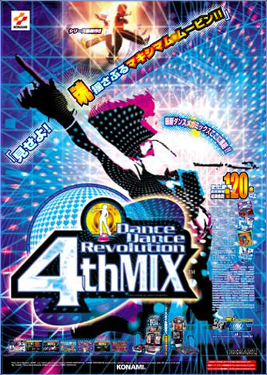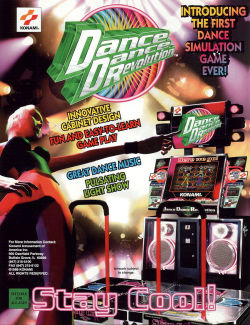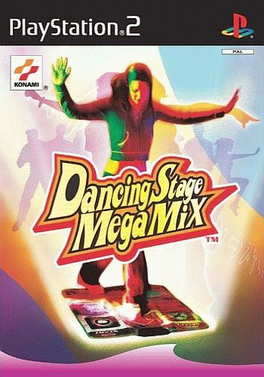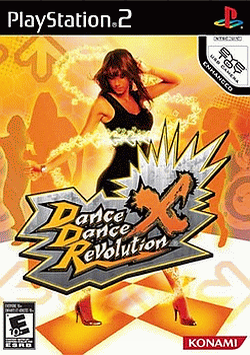Dance Dance Revolution (DDR) is a music video game series produced by Konami. Introduced in Japan in 1998 as part of the Bemani series, and released in North America and Europe in 1999, Dance Dance Revolution is the pioneering series of the rhythm and dance genre in video games. Players stand on a "dance platform" or stage and hit colored arrows laid out in a cross with their feet to musical and visual cues. Players are judged by how well they time their dance to the patterns presented to them and are allowed to choose more music to play to if they receive a passing score.
Dancing Stage is a series of music video games developed and published by Konami. It is a spin-off of Dance Dance Revolution for the European market as well as a few Japanese titles. Games were released for arcade, PlayStation, PlayStation 2 and Wii.

Beatmania IIDX (IIDX) is a series of rhythm video games, that was first released by Konami in Japan on 26 February 1999. Beatmania IIDX has since spawned 31 arcade releases and 14 console releases on the Sony PlayStation 2. It is the sequel to the beatmania game series, and is part of the Bemani line of music games.
Bemani, stylized as BEMANI, is Konami's music video game division. Originally named the Games & Music Division (G.M.D.), it changed its name in honor of its first and most successful game, Beatmania, and expanded into other music-based games, most notably rhythm games such as Dance Dance Revolution, GuitarFreaks, and DrumMania.

Pump It Up is a music video game series developed and published by Andamiro, a South Korean arcade game producer.
DDRMAX Dance Dance Revolution 6thMix is the 6th game in the Dance Dance Revolution series of music video games. It was released in the arcades by Konami on October 19, 2001, and for the PlayStation 2 on May 16, 2002, in Japan. 6thMix contains a total of 42 songs, all which made their first arcade appearance on this release. 11 of these songs debuted in various console releases prior to 6thMix. All arcade songs from Dance Dance Revolution to Dance Dance Revolution 5thMix were removed in 6thMix, although many of the Konami originals from those games would later be revived in future arcade releases.

Dance Dance Revolution 4thMix is the fourth game in the main Dance Dance Revolution series of music video games. It was released as an arcade game by Konami on August 24, 2000, in Japan. 4thMix features 136 songs, of which 37 are new songs available and 12 are new unlockables that require an operator code. Dance Dance Revolution 4thMix Plus is an update that unlocks these 12 songs without an operator code, while also adding 14 new songs of its own, for a total of 150 songs.

Dance Dance Revolution (DDR) is a music video game, developed by Konami, released in arcades on November 18, 1998, in Japan. Dance Dance Revolution is a unique game involving dance and rhythm that defined the genre. It involves timing and balance by having players use their feet instead of their hands like typical video games. In March 1999, the game was released for North American arcades, and for European arcades under the name Dancing Stage. Players and game critics were caught off-guard by the game's addictive qualities winning the new franchise many merits to its design.

Dance Dance Revolution SuperNova, released in Europe as Dancing Stage SuperNova is an arcade and PlayStation 2 game in the Dance Dance Revolution (DDR) series of music video games. It was produced by Konami and released through Betson Enterprises. The game was released in Europe on April 28, 2006, followed shortly by a North American release in May and a Japanese release on July 12.

Dancing Stage featuring Disney's Rave is a music video game released in Japan in arcades on November 30, 2000. On the same day, it was also released for the PlayStation, but under the name Dance Dance Revolution Disney's Rave. It was later released in September 2001 North America as Dance Dance Revolution Disney Mix and in Europe and Australia as Dancing Stage Disney Mix. It is based on Konami's Dance Dance Revolution (DDR) series with animated Disney characters and electronic dance music remixes of past Disney songs. They also include a few non-Disney songs that were popular at the time of the game's release. It is considered to be one of the rarest DDR game released in arcades.

Dancing Stage MegaMiX is the fifth home release in the Dancing Stage series, a European version of the Dance Dance Revolution series of music video games. MegaMix was the first Dancing Stage game released on the Sony PlayStation 2 game console - and as with Dancing Stage EuroMix 2, MegaMix introduced many new features to Europe, such as Freeze Arrows, the Options menu, and a cleaner interface. Based largely on Dancing Stage EuroMix 2, MegaMiX was separated from the arcade game by a completely different track list of songs. The game was marketed by Konami as a family game and an exercise tool in efforts to make the niche series more mainstream.

Dance Dance Revolution Extreme is a music video game by Konami and is the eighth release in the main Dance Dance Revolution (DDR) series. It was released on December 25, 2002, for Japanese arcades, on October 9, 2003, for the Japanese PlayStation 2, and on September 21, 2004, for the North American PlayStation 2. This game is the ninth release in North America, but despite having the same name as its Japanese counterpart, its gameplay and soundtrack is significantly different and won the Video Music Awards in 2005 on MTV for Best Video Game Soundtrack.

beatmania IIDX 7th Style is the seventh game in the beatmania IIDX series of music video games. It was released in arcades by Konami in March 2002.

Beatmania IIDX is an arcade music video game developed by Bemani and published by Konami. It was released in Japan on February 26, 1999. The objective is to perform songs using a controller with seven keys and a turntable. After the surprise success of Beatmania, Benami conceived IIDX to simulate an actual disc jockey (DJ) live performance. Its arcade cabinet contains a widescreen monitor, speakers, and eight spotlights. Bemani later developed several updated versions of IIDX to increased success. The game retrospectively received a positive reception from video game publications for its gameplay and increased difficulty. A sequel, Beatmania III, was released in 2000.

Dance Dance Revolution X is a music video game developed by Konami. A part of the Dance Dance Revolution series, it was announced in 2008 for Japan and on May 15, 2008, for the North American PlayStation 2. The arcade version was announced on July 7, 2008, July 9, 2008 in Europe, and July 10, 2008, for North America. Released to celebrate the 10th anniversary of Dance Dance Revolution, DDR X sports an improved interface, new music, and new modes of play. The arcade release featured an overhauled cabinet design with a widescreen display, e-Amusement and USB access, and an improved sound system. Despite such new design of its arcade cabinet, upgrade kit to change the edition of DDR on its first generation arcade cabinet from SuperNOVA2 to X is also available. The PlayStation 2 release has link ability with the arcade machine, multi-player support over LAN, and other improved and returning features such as EyeToy support. DDR X was called a "truly global version", with a multi-regional release by all three major Konami houses.
Dance Dance Revolution Extreme has a robust soundtrack. It includes many licensed tracks as well as in-house original music that was written and performed by Konami staff.

Dance Dance Revolution X2 is a music video game, and a part of the Dance Dance Revolution series. The arcade version of DDR X2 was revealed by Konami on November 20, 2009. The sequel to Dance Dance Revolution X, X2 began public beta testing on November 25, 2009. The game was released in Japan and Asia on July 7, 2010, North America on December 31, 2010, and Europe on May 13, 2011. It was the last arcade installment of Dance Dance Revolution with international releases until Dance Dance Revolution A.

Dance Dance Revolution II, later released in Europe as Dance Dance Revolution Hottest Party 5, is a music video game in the Dance Dance Revolution series by Konami. It was released on October 11, 2011 for the Nintendo Wii in North America and on November 25, 2011 in Europe. Dance Dance Revolution II is the direct sequel to Dance Dance Revolution for the Wii. This game shares songs with the arcade version of Dance Dance Revolution X3 vs 2ndMix. It features characters from the arcade versions of Dance Dance Revolution. It was the final DDR game release for the Nintendo Wii and is the latest in the series to be released for a home console as of 2024.
Dance Dance Revolution A is a music video game, the 15th installment of the Dance Dance Revolution arcade series in Japan, and the sequel to the 2014 release of Dance Dance Revolution. It was released on March 30, 2016 in Japan and Asia as a dedicated cabinet and as an upgrade kit, with Japan receiving a localized build, while the Korean release was delayed to the next week. This game was also released in North America later in 2016, in the form of new cabinets with e-Amusement connectivity, while Europe received new offline cabinets on December 15, 2017. It is the first international arcade release of Dance Dance Revolution since Dance Dance Revolution X2.













